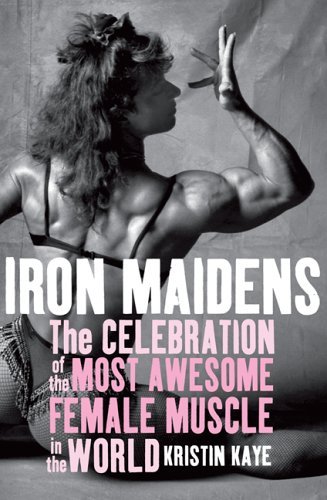Kristin
Kaye was a wide-eyed 23 year-old fresh out of drama school in
1993
when she responded to a classified ad that read: “administrative
assistant wanted for exciting women’s project.” What
she didn’t know at the time was that the project was a Broadway
show entitled “The Celebration of the Most Awesome Female
Muscle in the World,” the brainchild of bodybuilder and writer
Laurie Fierstein. Kaye ended up getting hired as the show’s
director and had just six weeks to put it together. Iron Maidens
is her funny, readable account of what followed: a regular girl’s
journey into the world of women’s bodybuilding.
 Although
Kaye was a “Title IX baby” with what she
calls “feminist tendencies”, she had never seen a female
bodybuilder before she came face-to-face with the 4-foot-10, 162-pound
Fierstein in a tiny New York apartment. But after hearing Fierstein’s
vision for the show, which was supposed to showcase women’s
physical and intellectual strength, Kaye was enthusiastic, feeling
like she “had been chosen for this position to represent
a new female voice, a voice that took the torch of feminism and
carried it for a new generation,” and got to work.
Although
Kaye was a “Title IX baby” with what she
calls “feminist tendencies”, she had never seen a female
bodybuilder before she came face-to-face with the 4-foot-10, 162-pound
Fierstein in a tiny New York apartment. But after hearing Fierstein’s
vision for the show, which was supposed to showcase women’s
physical and intellectual strength, Kaye was enthusiastic, feeling
like she “had been chosen for this position to represent
a new female voice, a voice that took the torch of feminism and
carried it for a new generation,” and got to work.
Needless
to say, the show turned out somewhat differently than Kaye expected.
She alternates between telling the chaotic story
of her struggle to co-ordinate 25 performers and egos, all with
different, wacky ideas of what they want to do onstage, from lifting
guys above their heads to stripping, and telling the history of
female bodybuilding, from its beginnings in the late 1970s right
through to last year’s IFBB ruling telling female bodybuilders,
fitness and figure athletes to become 20% less muscular. There
are also sections on steroids, sessions, and a great description
of the 2003 Nationals in Miami Beach (“What a competition
is like”), which brilliantly conveys the atmosphere at a
big contest.
What
makes this book unique is that Kaye writes from the perspective
of
an outsider seeing the world of women’s bodybuilding for
the first time, but is also great at getting inside the heads of
the competitors she encounters. In a great chapter called “What
it’s like to be a Female Bodybuilder” that even fans
of women’s bodybuilding will learn something from, the author
follows national-level heavyweight Sheila Bleck through her contest
prep. Describing the last week before the show, she writes: “During
this time Sheila feels untouchable, as if she’s floating
out of this world, and also as if she could cry. […] She’s
in a weird twilight zone and is wired and sleepy all at the same
time.”
In
chapters like this, which were written several years after “The
Celebration” is over, it’s obvious that Kaye has moved
beyond her initial shock and bafflement at female bodybuilders,
through fascination, to genuine admiration for them. Hopefully,
a lot of readers will do too.
“Iron
Maidens” is
published September 13, 2005. To order from Amazon.com, click
here.
More info at www.kristinkaye.com.

